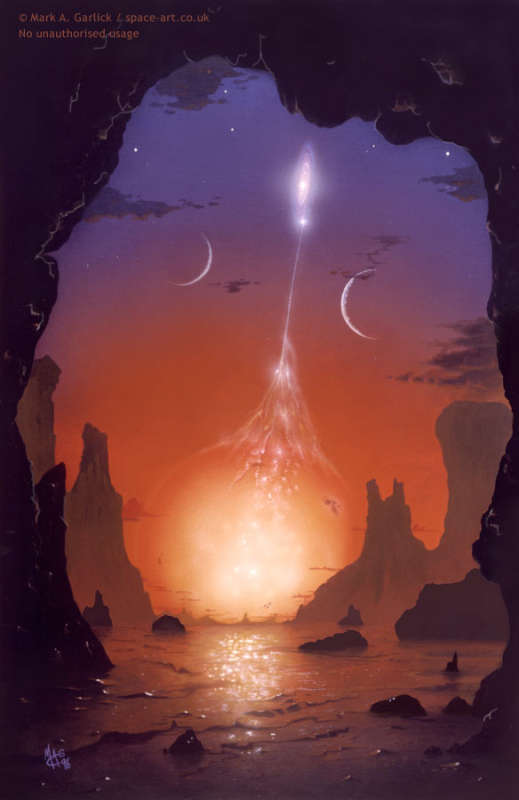Credit & Copyright: Mark A. Garlick
(Space-art.co.uk)
Explanation:
Will this dawn bring another nova?
Such dilemmas might be pondered one day by
future humans
living on a planet orbiting a
cataclysmic variable
binary star system.
Cataclysmic variables involve gas falling from a large star onto an
accretion disk surrounding a massive but compact
white dwarf star.
Explosive cataclysmic events such as a
dwarf nova
can occur when a clump of gas in the interior of the
accretion disk
heats up past a certain temperature.
At that point, the clump will fall more quickly onto the
white dwarf and land with a
bright flash.
Such dwarf novas will not destroy either star, and may occur irregularly on time
scales from a few days to tens of years.
Although a nova is much less energetic than a supernova, if
recurrent novas are not
violent enough to expel more gas than is falling in,
mass will accumulate onto the white dwarf star until it passes its
Chandrasekhar limit.
At that point, a foreground cave may provide little protection,
as the entire white dwarf star will explode in a
tremendous supernova.
1999 2000 2001 2002 2003 2004 2005 2006 2007 2008 2009 2010 2011 2012 2013 2014 2015 2016 2017 2018 2019 2020 2021 2022 2023 2024 2025 |
Yanvar' Fevral' Mart Aprel' Mai Iyun' Iyul' Avgust Sentyabr' Oktyabr' Noyabr' Dekabr' |
NASA Web Site Statements, Warnings, and Disclaimers
NASA Official: Jay Norris. Specific rights apply.
A service of: LHEA at NASA / GSFC
& Michigan Tech. U.
|
Publikacii s klyuchevymi slovami:
binary star - cataclysmic variable - dvoinye zvezdy - dvoinaya sistema - kataklizmicheskie peremennye - novye zvezdy - Sverhnovye - Chandrasekarovskaya massa - predel Chandrasekara
Publikacii so slovami: binary star - cataclysmic variable - dvoinye zvezdy - dvoinaya sistema - kataklizmicheskie peremennye - novye zvezdy - Sverhnovye - Chandrasekarovskaya massa - predel Chandrasekara | |
Sm. takzhe:
Vse publikacii na tu zhe temu >> | |
